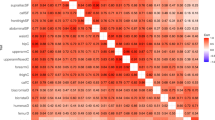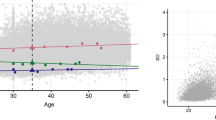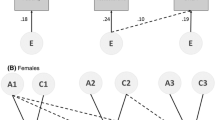Abstract
The heritability of total plasma testosterone levels, determined from blood samples, was examined in 160 adolescent twin pairs and their parents. Subjects were tested as part of a larger study of cardiovascular risk factors, conducted in Amsterdam. Each subject provided a sample of blood which was assayed to measure testosterone concentrations. Correlations of testosterone in monozygotic twins were higher than in dizygotic twins. No resemblance was found between testosterone values in fathers and those in their children and a moderate correlation was seen between mothers and their daughters. The lack of resemblance between family members of opposite sex suggests that different genetic factors influence plasma testosterone concentrations in men and women. In adolescent men, approximately 60% of the variance in testosterone levels is heritable. The lack of father–son resemblance suggests that different genetic factors may be expressed in adolescence and adulthood. In women, 40% of the variance in testosterone levels is heritable, both in adolescence and in adulthood.
Similar content being viewed by others

REFERENCES
Albert, D. J., Walsh, M. L., and Jonik, R. H. (1993). Aggression in humans: What is its biological foundation? Neurosci. Biobehav. Rev. 17:405–425.
Alexander, G. M., Sherwin, B. B., Bancroft, J., and Davidson, D. W. (1990). Testosterone and sexual behavior in oral contraceptive users and nonusers: A prospective study. Hormones Behav. 24:388–402.
Archer, J. (1991). The influence of testosterone on human aggression. Br. J. Psychol. 82:1–28.
Archer, J. (1994a). Testosterone and aggression. In Hillbrand, M., and Pallone, N. J. (eds.), The Psychobiology of Aggression, Haworth Press, New York, pp. 3–35.
Archer, J. (1994b). Testosterone and aggression. J. Offend. Rehab. 21:3–39.
Bancroft, J., Davidson, D. W., Warner, P., and Tyrer, G. (1980). Androgens and sexual behavior in woman using oral contraceptives. Clin. Endocrinol. 12:327–340.
Beatty, W. W. (1992). Gonadal hormones and sex differences in nonreproductive behaviors. In Gerall, A. A., Moltz, H., and Ward, I. L. (eds.), Handbook of Neurobiology, Vol. 11, Plenum Press, New York, pp. 85–128.
Boomsma, D. I., Hennis, B. C., Kluft, C., and Frants, R. R. (1993a). A parent-twin study of plasma levels of histidine-rich glycoprotein (HRG). Thromb. Haemostat. 70:848–851.
Boomsma, D. I., Kaptein, A., Kempen, H. J. M., Gevers-Leuven, J. A., and Princen, H. M. G. (1993b). Lipoprotein (a): Relation to other risk factors and genetic heritability. Results from a Dutch parent-twin study. Atherosclerosis 99:23–33.
Boomsma, D. I., Koopmans, J. R., Van Doornen, L. J. P., and Orlebeke, J. F. (1994). Genetic and social influences on starting to smoke: A study of Dutch adolescent twins and their parents. Addiction 89:219–226.
Boomsma, D. I., Kempen, H. J. M., Gevers-Leuven, J. A., Havekes, L., de Knijff, P., and Frants, R. R. (1996). Genetic analysis of sex and generation differences in plasma lipid, lipoprotein and apolipoprotein levels in adolescent twins and their parents. Genet. Epidemiol. 13:49–60.
Booth, A., and Osgood, D. W. (1993). The influence of testosterone on deviance in adulthood: Assessing and explaining the relationship. Criminology 31:93–117.
Dabbs, J. M., Jr. (1990). Age and seasonal variation in serum testosterone concentrations among men. Chronobiol. Int. 7:245–249.
Dabbs, J. M., Jr., and Morris, R. (1990). Testosterone, social class, and antisocial behavior in a sample of 4,462 men. Psychol. Sci. 1:209–211.
Dabbs, J. M., Jr., Ruback, R. B., Frady, R. L., Hopper, C. H., and Sgoutas, D. S. (1988). Saliva testosterone and criminal violence among women. Person. Indiv. Diff. 9:269–275.
Dent, R. R. M. (1983). Endocrine correlates of aggression. Prog. Neuro-Psychopharmacol. Biol. Psychiatry 7:525–528.
Deslypere, J. P., and Vermeulen, A. (1984). Leydig cell function in normal men: Effect of age, lifestyle, residence, diet, and activity. J. Clin. Endocrinol. Metab. 59:955–962.
Gladue, B. A. (1991). Aggressive behavioral characteristics, hormones, and sexual orientation in men and women. Aggress. Behav. 17:313–326.
Gray, A., Jackson, D. N., and McKinlay, J. B. (1991). The relation between dominance, anger, and hormones in normally aging men: Results from the Massachusetts male aging study. Psychosom. Med. 53:375–385.
Harris, J. A., Rushton, J. P., Hampson, E., and Jackson, D. N. (1996). Salivary testosterone and self-report aggressive and prosocial personality characteristics in men and women. Aggress. Behav. 22:321–331.
Julian, T., and McKenry, P. C. (1989). Relationship of testosterone to men's family functioning at mid-life: A research note. Aggress. Behav. 15:281–289.
Meikle, A. W., Bishop, D. T., Stringham, J. D., and West, D. W. (1987). Quantitating genetic and nongenetic factors that determine plasma sex steroid variation in normal male twins. Metabolism 35:1090–1095.
Meikle, A. W., Stringham, J. D., Bishop, D. T., and West, D. W. (1988). Quantitating genetic and nongenetic factors influencing androgen production and clearance rates in men. J. Clin. Endocrinol. Metab. 67:104–109.
Neale, M. C. (1997). Mx: Statistical Modeling, 2nd ed., Department of Psychiatry, Medical College of Virginia, Richmond.
Neale, M. C., and Miller, M. B. (1997). The use of likelihood-based confidence intervals in genetic models. Behav. Genet. 27:113–120.
Persky, H. Smith, K. D., and Basu, G. K. (1971). Relation of psychologic measures of aggression and hostility to testosterone production in man. Psychosom. Med. 33:265–277.
Riad-Fahmy, D., Read, G. F., and Walker, R. F. (1983). Salivary steroid assays for assessing variation in endocrine activity. J. Steroid Biochem. 19:265–302.
Rose, R. M. (1978). Neuroendocrine correlates of sexual and aggressive behavior in humans. In Lipton, M. A., DiMascio, A., and Killam, K. F. (eds.), Psychopharmacology: A Generation of Progress, Raven, New York, pp. 541–552.
Rushton, J. P., Fulker, D. W., Neale, M. C., Nias, D. K. B., and Eysenck, H. J. (1986). Altruism and aggression: The heritability of individual differences. J. Person. Soc. Psychol. 50:1192–1198.
Van Goozen, S., Frijda, N., and Van de Poll, N. (1994). Anger and aggression in women: Influence of sports choice and testosterone administration. Aggress. Behav. 20:213–222.
Van Goozen, S., Cohen-Kettenis, P. T., Gooren, L. J. G., Frijda, N., and Van de Poll, N. (1995). Gender differences in behavior: Activating effects of cross-sex hormones. Psychoneuroendocrinology 20:343–363.
Author information
Authors and Affiliations
Rights and permissions
About this article
Cite this article
Harris, J.A., Vernon, P.A. & Boomsma, D.I. The Heritability of Testosterone: A Study of Dutch Adolescent Twins and Their Parents. Behav Genet 28, 165–171 (1998). https://doi.org/10.1023/A:1021466929053
Issue Date:
DOI: https://doi.org/10.1023/A:1021466929053



